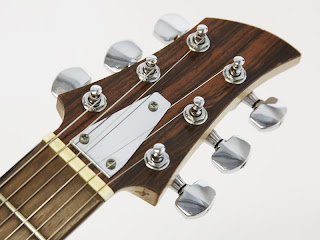Ampeg, Dan Armstrong - Plexiglass, "See through" guitar
In 1969 Ampeg, known for its amps for guitars and bass guitars, together with guitar builder Dan Armstrong, presented their plexiglass guitar at the NAMM show in Chicago. It was one of the highlights of the NAMM show that year, as it was the first plexiglass guitar ever. Soon after, the Ampeg Dan Armstrong (ADA) was widely known as the "see through" guitar. The guitar was produced from 1969 - 1971, and several famous rock guitarists played the Ampeg Dan Armstrong, boosting its popularity. Between 1998 and 2001, the ADA, again for a short time, was produced in Japan. More than 40 years after the introduction of the original, the "see through" guitar still looks revolutionary. Since 2006, the plexiglass Ampeg Dan Armstrong is produced again; the same futuristic look, but with some significant changes.
 |
| ampeg dan armstrong plexiglass body |
The original concept of the Ampeg Dan Armstrong
Dan Armstrong intended to build an electric guitar with excellent sustain, and came up with the idea of using plexiglass for the body of the guitar because of the rigid qualities of the material. Apart from the plexiglass body, the Ampeg Dan Armstrong has more innovative features. One of them is the presence of two strap-buttons on the body, which makes it possible to easily stand the guitar upright, still pretty unique. In my view, the main feature, besides the "see through" body, is the possibility to change the pickups by sliding them in and out the body, and connect them with two plugs. The original ADA gave the choice between 7 single coil pickups, designed by Arstrong and Bill Lawrence! A great idea, and I wonder why other guitar builders didn't "pick up" the concept.
The plexiglass body of the Ampeg Dan Armstrong is somewhat thinner than the average electric guitar body, but still, the guitar is relatively heavy, around 4,5 kg.
One of the main problems of the original design was tuning instability. The way the neck was bolted to the body, "clear off", using large bolts, resulted in less wood in the "tongue " of the neck, which caused the problem.
The plexiglass body of the Ampeg Dan Armstrong is somewhat thinner than the average electric guitar body, but still, the guitar is relatively heavy, around 4,5 kg.
One of the main problems of the original design was tuning instability. The way the neck was bolted to the body, "clear off", using large bolts, resulted in less wood in the "tongue " of the neck, which caused the problem.
 |
| ampeg dan armstrong plexiglass pickguard |
The "new" Ampeg Dan Armstrong, major improvements
To resolve the tuning instability issues, the latest Ampeg Dan Armstrong has a new neck joint, with smaller screws, mounted on the back of the guitar, combined with high quality Grover tuners. With the original ADA equiped with 7 pickups, the new Ampeg Dan Armstrong only has 2 exchangeable pickup, so the original versatility is limited. Like the ADA's produced in Japan between 1998 - 2001, the pickups are designed by Kent Armstrong, Dan's son. Both pickups, one single coil Rock Treble, and one Sustain Treble humbucker, are huge; the room is needed for the large gauge wire, according to Kent Armstrong, used to create better tone.
Last but not least, the neck profile returned to the original profile, instead of the slimmer neck profile of the Japan made ADA's.
 |
| ampeg dan armstrong plexiglass headstock |
The Ampeg Dan Armstrong in the "Rock Scene".
Lot's of rockers were, and still are, happy to be seen with a "see through" Ampeg Dan Armstrong. From the original ADA, played in 1969 by Rolling Stones' Keith Richard and Bill Wyman, Leslie West and Paul McCartney, to the latest version, used by the Foo Fighters and the Red Hot Chili Peppers. The plexiglass Ampeg Dan Armstrong hasn't lost any of it's attraction.
 |
| ampeg dan armstrong plexiglass body back |
 |
| ampeg dan armstrong plexiglass pickup |
No comments:
Post a Comment